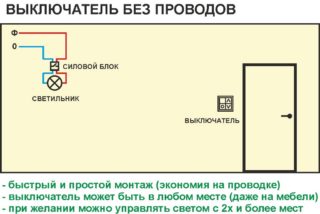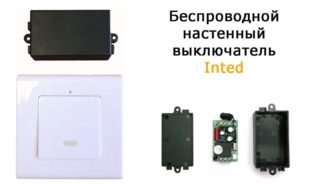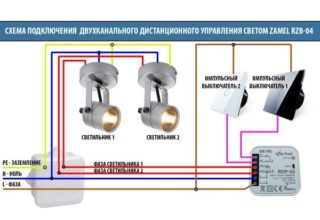Non-contact devices for switching off the light exclude touching the buttons with your hands. The wireless switch works remotely by transmitting a signal to the receiver. The multifunctional device facilitates the process of lighting control and provides control of its intensity. Installation does not take much time and is easy to do by hand.
- Design and principle of operation
- Receiver features
- The specifics of the transmitter
- Characteristics of wireless devices
- Types of wireless switches
- Areas of use
- Pros and cons
- Proximity Module Selection Options
- Popular manufacturers
- Feron
- Inted
- BAS
- Smartbuy
- Z-Wave
- Nootechnics
- Self-connection
- Connection instructions
- Tuning and reprogramming technology
- Switch setting
Design and principle of operation
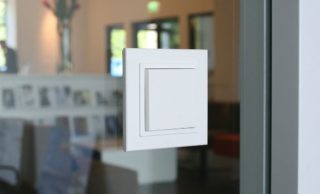
The contactless switch is equipped with two working units - a transmitter and a receiver.
Receiver features
The receiver is a radio-controlled relay that picks up the signal and closes the galvanic circuit. The installation of the mechanism is carried out next to the lighting device or in the coverage area of the transmitter. For control, a remote control, radio waves, a smartphone or tablet application that works with Wi-Fi is used.
The receiver can be mounted in a suspended ceiling, chandelier, floor lamp, sconce, distribution box.
The specifics of the transmitter
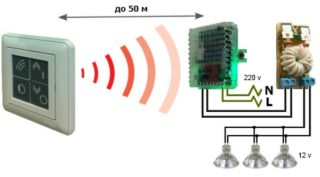
The device operates without being connected to the mains, compatible with LEDs and incandescent lamps. In budget models, a battery is used, in "advanced" - a generator that generates current when you press a button. The resulting energy impulse is transformed into a radio signal. The receiver picks it up. Battery powered models need to be recharged as they are discharged.
The commands to the module are received from the control panel, from the phone via Wi-Fi or Bluetooth. The signal coverage area varies from 20 to 350 meters. In the presence of a dimmer, the user adjusts the level of illumination, brightness. It is enough to press and hold the operating key.
One remote control can control 8 gadgets.
Characteristics of wireless devices
- control using buttons, sensors or remote control;
- the presence or absence of light intensity adjustment;
- the number of devices in the system (from 1 to 8);
- range - from 10 m as standard, 15-20 m in the presence of a concrete wall, 100-150 m in line of sight;
- autonomy - runs on batteries or from a mini-generator.
The budget modifications have all the listed functions. Advanced gadgets are equipped with several options:
- delayed start - they do not start working immediately, but at the moment they leave the room;
- multichannel - control of several switches within the same building;
- the presence of a touch panel - activation by touch;
- signal reception via Wi-Fi - signals are sent from a smartphone, computer, tablet.
The more functions, the more expensive the switch.
Types of wireless switches
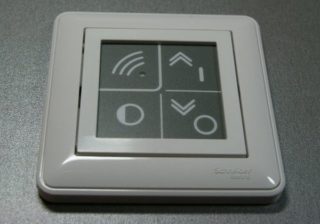
Wireless light switches are classified according to several parameters.
There are models according to the control method:
- with control of the lighting system by mechanical buttons;
- with touch control: switching is done by fingers, the human body changes the electrostatic field of the capacitor, which triggers the switching circuit; sensory models are designed for 100 thousand cycles;
- with a two-button remote control: after holding the button for 0.1-1 sec, digital signals are sent to the switch, one button is designed to turn on and adjust the brightness, the second - to turn off and lower the light intensity;
- with Wi-Fi sensors: the principle of operation is the appearance of an impulse after a command from a remote device, the signal frequency is 2.4-5 GHz.
Also the classification is made:
- By the number of channels in the system. The remote control can control from 1 to 8 groups of luminaires, regardless of the number of bulbs. A multichannel gadget allows you to adjust the lighting in an apartment or house, but remembers the address of its "own" bitrate, ie. remote control.
- By the presence of a dimmer. There is no smooth adjustment in budget models. Smart switches with dimmers can turn off and activate light bulbs, adjust the intensity and brightness of the light flux.
A non-contact device receives a signal through furniture, walls, interior items.
Areas of use
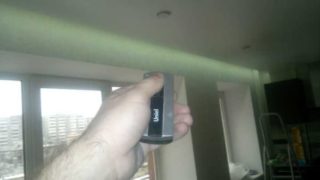
It is advisable to operate the proximity switch in several situations:
- Transferring your old device. If you have bulky furniture, the device can be installed on a wall, in a closet, or on a mirror.
- Elimination of assembly errors. In the process of transferring the power line, the wall slitting is excluded. It is enough to connect the device with or without a remote control.
- Small room. Wireless devices are overhead, so there is no need to lay a cable. The device will fit on a coffee table, cabinet, chest of drawers, bar counter.
- Ensuring the comfort of using electrical appliances. The contactless system takes up a minimum of space, is easy to operate and features manufacturability.
- Accommodation in a wooden house. When arranging hidden wiring, it is worth observing safety requirements, and an open network is susceptible to mechanical damage. Connecting remote gadgets will be an economical and simple solution.
- Lighting control in multiple rooms. A small device with a remote control allows you to control light sources from 2-3 zones.
- The need for additional switching devices. The switches are installed after the end of construction without disrupting the decoration and communications.
- Turning on and off the light at a great distance. The cable is expensive to lay, and the radio switch, depending on the model, works in a range of up to 350 m.
- Preservation of the design concept. If it is impossible to install switches in a niche or in an overhead way, the wireless device will complement any interior style.
Wireless miniature light source switches - an alternative to traditional mechanisms due to their ease of installation and control.
Pros and cons
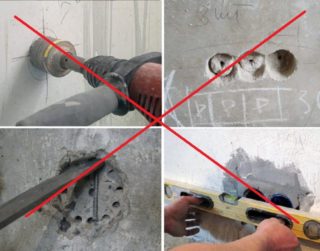
Devices that remotely control lighting have advantages and disadvantages. The advantages of their operation include:
- ease of self-installation;
- no need for wall chipping and cable laying;
- convenient control of all lighting systems using the remote control or from a smartphone;
- large range of transmission and reception of signals;
- no risk of electric shock;
- safety for children.
Among the disadvantages of wireless modules are the high cost in comparison with wired modifications, the dependence on the stability of Wi-Fi and the inability to use with a discharged battery.
Proximity Module Selection Options
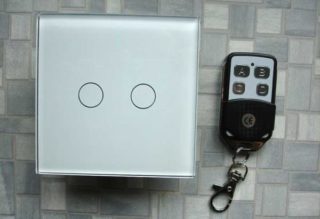
Before purchasing a proximity switch, pay attention to the following characteristics:
- block type - the outer one can be put in place of the standard device, the inner one is mounted after removing the chandelier;
- layout - the kit includes a remote control, charger, rarely - a battery and a holder;
- features of lighting lamps - devices are compatible with LEDs, halogens and incandescent bulbs;
- operating frequency - ranges from 2.2 to 5 GHz, which determines the quality of reception and transmission of signals;
- range - budget models operate at a distance of 10 m, luxury models - at a distance of 100 to 350 m;
- power - contactless equipment has a maximum load limit of 1000 W, but you need to select a power unit with a power 20% more than the declared one;
- number of clicks - the battery runs out after 10-20 touches, the sensor is designed for up to 100 thousand touches;
- current rating - from 6 to 16 A;
- number of channels - modern devices receive a signal from 1-8 sources.
Important characteristics are also the material of the case, the presence of the coding system, the permissible temperature range of use and the method of fastening.
Popular manufacturers
There are several modifications of contactless sockets and switches on the Russian market. It is advisable to consider the products of popular brands.
Feron
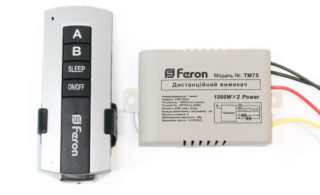
The following models are relevant in apartments and private houses:
- TM-75. Plastic switch with start delay setting for 220 V mains. Equipped with 20 channels. The set includes a remote control.
- TM72. A remote control is used for control, the devices are connected to 2 channels with a capacity of up to 1 kW for different light sources. Delay of work - 10-60 sec.
Both devices have a coverage radius of 30 m.
Inted
- 220V. One-keyboard with wall mounting (self-tapping screws or double-sided tape) under a voltage of 20 V. The radius of action is 50 m, amplified by the signal receiving unit. The body is plastic.
- 1-CH. Designed for lamps up to 900 W, controls light and alarms. It is made in the form of a key fob that broadcasts a signal at 100 m. In wet rooms it quickly breaks down.
The Inted 220V series also includes a dual receiver model with two channels.
BAS
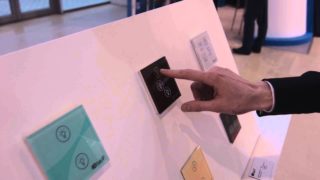
The inductive switch IP SH-74 has two independent channels. Controlled from a smartphone through a branded application. Compatible with incandescent bulbs up to 500 W and fluorescent lamps 200 W.
Smartbuy
Three-channel device with a power limit of 280 W and a voltage of 220 V. It receives and transmits a signal from 30 m.
Z-Wave
8 devices are connected to the radio-controlled gadget. Power is supplied by two batteries. The maximum range of action is 75 m. The case is moisture resistant, with protection IP30.
Nootechnics
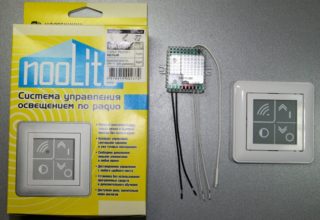
The Belarusian brand Nootechnika nooLite has a line of products with programmable modes. They are activated using a multi-channel RGB controller. There is a dimmer for dimming.
The sapphire-2503 infrared model is available with a dimmer, but is not suitable for energy-saving lamps. The lighting turns off some time after the user leaves the room. The load limit is from 40 to 400 W.
All devices are compact and easy to install.
Self-connection
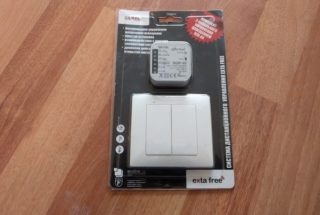
You can consider the features of connecting a non-contact limit switch using the example of Zamel RZB-04. It is equipped with a two-channel receiver, a two-channel switch with 4 modes, mounting brackets. The device has 5 operating modes:
- Turning on. After the button is pressed in any position, the lamps light up or go out.
- Shutdown. Occurs when a key is pressed.
- Monostability. Works in the pressed button mode. After releasing it, the light will go out.
- Bistability. To turn on / off the light, use a successive press.
- Temporary regime. The pressed button starts the operation of the device for a short period.
Read the user manual before using the device.
Connection instructions
The connection diagram depends on the number of channels.Single-channel are connected by breaking the phase cable connected to the luminaire and inserting the core to the Lin and Lout terminals. Multichannels are installed as follows:
- The power supply is de-energized and the voltage is checked with an indicator screwdriver.
- The old switch mechanism is removed.
- Voltage is applied, but only phase is directed to the breaker. It must be constant, for which it is connected to one of the conductors with terminal blocks.
- The phase is thrown on contact L without passing a wire through the devices.
- A zero is connected to contact N using a wire from the switchboard.
- It is better to make a connection to the OUT1 terminal with a phase wire directed to one or more light sources. The neutral is taken from the box or receiver.
- The OUT2 contact is connected to a phase that goes to the second group or one light source. The neutral is taken from the shield or receiver.
- A pulse transmitter is connected to the INT1 contact, sending short signals. It will provide control from a remote control or a stationary switch.
- An impulse switch is connected to the INT2 contact according to the scheme indicated in the previous paragraph.
In the final stage, the switch is connected and electricity is supplied.
Tuning and reprogramming technology
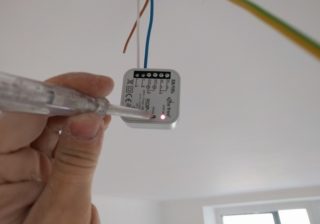
First you need to select the operating mode of the system. By default, this is the standard functionality with the transfer of the wireless device up to enable and down to disable. To reprogram you should:
- Using a screwdriver, press the PROG button of device No. 2 and hold it until the red light comes on.
- Duplicate the action on the top of the radio switch button. Wait until the red light comes on.
- Press down on the bottom until the diode is activated.
The rest of the actions are performed according to a similar algorithm with the second key.
Switch setting
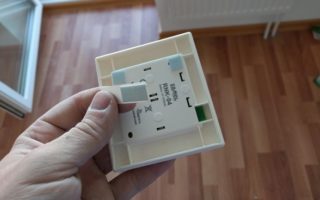
The delivery set includes double-sided tape or dowels with self-tapping screws. When working with tape, the use of tools is excluded and the adjustment of the position of the device is facilitated. The tape is cut into 4 pieces, which are glued to the device.
After installation, the test lamp is installed and the system is checked. It is necessary to move the button to the upper and then to the lower position. The start is indicated by a light indicator.
The place for installation can be cabinet doors, a safe, a plasterboard partition. On the door, the switch can be set at the level of the child's outstretched arm. The headboard, wall and floor will create additional comfort of use.
The portable light controller is easy to use due to its low weight and flat shape. The module is easily attached to double-sided tape. The presence of auxiliary functions, the variability of the radius of action and the number of channels will allow you to choose the appropriate model for an apartment, office or house.

